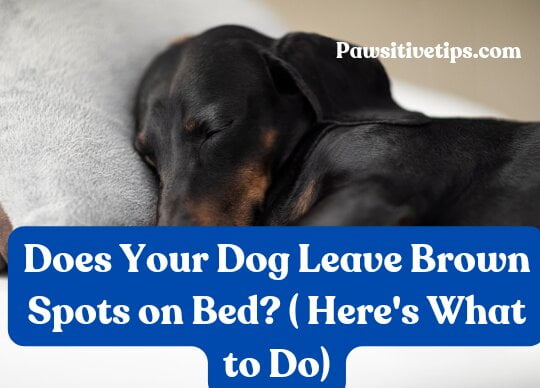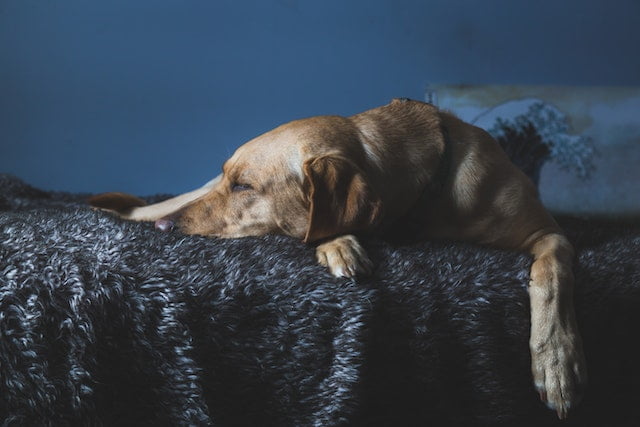Does Your Dog Leaves Brown Spots on Bed? ( Here’s What to Do) 2024

I know the the majority of us dog owners love our dogs unconditionally, but what if you notice that your dog leaves brown spots on bed whenever it sleeps or plays on it? How would you feel? This is indeed a frustrating issue and must be tackled as soon as possible to avoid turning your precious bedding into a dirt pit.
Whether it’s urine stains, saliva marks, or other bodily fluids, dealing with this problem can be both challenging and disheartening. In this article, we’ll check out the causes behind these brown spots and provide you with effective solutions to keep your dog’s bed clean and fresh.
What Causes Your Dog to Leave Brown Spots on Bed?
If you discover that your dog always leaves brown spots on your bed whenever it sleeps in it, here are some of the causes of the brown spots:
1. Urine Stains
One of the primary causes of brown spots on beds is urine stains. Dogs may accidentally urinate on the bed due to various reasons, such as inadequate house training, medical issues, or even territorial marking. The high concentration of urea in urine can lead to discoloration and unpleasant odors.
2. Saliva Stains
Dogs have a natural tendency to drool, especially when they are excited, anxious, or anticipating a meal. Excessive saliva can leave unsightly stains on the bedding, particularly if your dog likes to rest their head on the bed or if they frequently lick or chew on their bedding.
3. Sweat and Body Oils
Just like humans, dogs have sweat glands that produce sweat and body oils. When they sleep on your bed, these substances can transfer to the fabric, resulting in brown spots over time. Additionally, dogs with oily skin or those that have not been groomed regularly may leave more visible spots on the bed.
4. Outdoor Elements
Dogs often explore the outdoors, rolling in grass, dirt, or other substances. When they return to your bed, they can bring in these elements, causing stains and dirt accumulation. This is especially true if your dog loves outdoor activities, such as playing in the mud or running through wet grass.
5. Medical Conditions
Certain medical conditions can contribute to the presence of brown spots on your bed. Dogs with urinary tract infections, incontinence, or other urinary issues may have more frequent accidents on the bed, leading to stains. Similarly, dogs with excessive drooling due to dental problems or certain medical conditions may leave more saliva stains on the bedding.
6. Stress or Anxiety
Dogs experiencing stress or anxiety may exhibit behaviors such as excessive drooling, panting, or urination accidents. These behaviors can contribute to the presence of brown spots on the bed. It’s important to address the underlying causes of stress or anxiety and provide appropriate training and support to reduce these behaviors.
7. Old age or mobility issues
Older dogs or those with mobility issues may find it challenging to control their bodily functions. This can result in accidents on the bed, including urine stains. Joint pain or muscle weakness can make it difficult for them to reach their designated potty area in time, leading to brown spots on the bed.
8. Dietary Factors
Some dietary factors can influence the color and odor of a dog’s urine and feces. Certain foods or treats may cause the urine to become more concentrated or alter its pH balance, which can contribute to the development of brown spots on the bed. It’s essential to provide a balanced and appropriate diet for your dog’s overall health.
How To Prevent Your Dog From Leaving Brown Spots On Bed
To prevent and minimize the occurrence of brown spots on your bed, consider the following methods:
1: Proper Dog Training and Behavior Modification
Proper training is important to prevent dogs from leaving brown spots on the bed. Follow these tips:
- House Training: Ensure your dog is properly housetrained, including teaching them where they should eliminate.
- Positive Reinforcement: Use positive reinforcement techniques to reward and reinforce desired behaviors, such as using designated potty areas or staying off the bed.
2: Using Protective Covers and Bedding
Investing in protective covers and bedding can help prevent brown spots on your dog’s bed. Consider the following options:
- Waterproof Covers: Choose waterproof covers that can prevent urine or drool from seeping into the mattress or bedding.
- Stain-Resistant Fabrics: Opt for stain-resistant fabrics that are easy to clean and can repel stains caused by saliva or body oils.
- Removable and Washable Bedding: Select bedding materials that are removable and machine washable, allowing for regular cleaning and stain removal.
3: Regular Grooming and Hygiene
Maintaining your dog’s hygiene can minimize the occurrence of brown spots on the bed. Follow these practices:
- Regular Bathing: Bathe your dog regularly using a gentle, pet-friendly shampoo to reduce body oils and odors.
- Paw Wiping: After outdoor activities, wipe your dog’s paws with a clean towel or pet wipes to remove any dirt or outdoor elements that could be transferred to the bed.
- Mouth and Face Cleaning: Pay attention to your dog’s drooling habits and wipe their mouth and face with a clean cloth or pet-friendly wipes as needed.
4: Establish a Comfortable Resting Area
Providing your dog with a designated resting area can also deter them from using the bed. Consider the following strategies:
- Dog Bed or Crate: Provide your dog with a comfortable and well-fitted bed or crate where they can rest and feel secure.
- Positive Reinforcement: Encourage your dog to use their designated resting area by providing rewards, treats, or praise when they choose that space over the bed.
5: Proper Supervision and Management
Keeping an eye on your dog’s behavior and managing their access to the bed can help prevent accidents and stains. Consider the following:
- Supervision: Supervise your dog’s activities and behavior when they are on or near the bed, especially if they have a history of accidents.
- Limited Access: Restrict access to the bed when you are not able to supervise, such as when you are away from home or during the night.
6: Regular Bathroom Breaks
Ensure your dog has regular bathroom breaks to prevent accidents on the bed. Here’s what to do:
- Establish a routine: Set a consistent schedule for bathroom breaks, including morning, afternoon, and evening walks or potty breaks.
- Frequent Outdoor Time: Provide ample opportunities for your dog to eliminate outdoors and encourage them to do so before settling on the bed.
Cleaning and brown spot removal techniques
When you encounter fresh brown spots on your bed, follow these steps for effective stain removal:
When your dog leaves brown spots on your bed or its bed, it’s essential to take prompt action and use appropriate cleaning techniques. Here are some steps and methods to effectively clean and remove brown spots:
1. Immediate Action for Fresh Stains
- As soon as you notice a fresh brown spot on the bed, act quickly to prevent it from setting in.
- Use a clean cloth or paper towel to gently blot the area and absorb any excess moisture.
- Avoid rubbing or scrubbing the stain, as it can spread the spot and make it more difficult to remove.
2. Choosing the Right Cleaning Products:
- Selecting the right cleaning products is crucial to ensuring effective stain removal without damaging the fabric.
- Look for pet-safe and fabric-friendly cleaning solutions specifically designed for stain removal.
- Avoid using harsh chemicals or bleach, as they can be harmful to your dog’s health and may cause color fading or fabric damage.
3. Step-by-Step Cleaning Process
Follow these steps to clean and remove brown spots from your dog’s bed:
- Preparation: Before starting the cleaning process, gather the necessary supplies, including cleaning solution, a clean cloth, and water.
- Spot Testing: Perform a spot test on a small, inconspicuous area of the bed to ensure the cleaning solution doesn’t cause any adverse effects on the fabric. Wait a few minutes and check for any color fading or fabric damage.
- Application: Apply a small amount of the chosen cleaning solution to a clean cloth or sponge. It’s best to avoid directly pouring the solution onto the bed to prevent excessive saturation.
- Blotting: Gently blot the stained area with the cloth or sponge, working from the outer edges of the stain toward the center. This helps prevent the stain from spreading.
- Repeating: If the stain persists, repeat the blotting process with a fresh cleaning solution until the stain gradually lifts.
- Rinsing: After removing the stain, rinse the area thoroughly with clean water to remove any remaining residue from the cleaning solution.
- Drying: Allow the bed to air dry completely before using it again. Direct sunlight or a well-ventilated area is ideal for drying, as it helps eliminate any remaining moisture and prevents mildew growth.
Natural Remedies for Stain Removal
If you prefer natural alternatives, several household ingredients can effectively remove brown spots from your dog’s bed. Here are some common natural remedies:
- Vinegar and Water Solution: Create a mixture of equal parts white vinegar and water in a spray bottle. Spray the solution onto the stain and let it sit for a few minutes before blotting with a clean cloth.
- Baking Soda and Hydrogen Peroxide Paste: Make a paste by combining baking soda and hydrogen peroxide. Apply the paste to the stain, gently rub it in using a soft brush or cloth, and let it sit for about 15 minutes before rinsing and blotting.
- Lemon Juice and Salt Mixture: Squeeze fresh lemon juice onto the stain and sprinkle salt over it. Gently rub the mixture into the stain and let it sit for approximately 30 minutes. Rinse thoroughly with water and blot dry.
Natural remedies can be effective, but it’s essential to test them on a small, inconspicuous area of the bed first to ensure they don’t cause any discoloration or fabric damage.
Using A Professional Cleaning Service
In some cases, professional cleaning services may be necessary, especially if the brown spots are deeply set or the bed requires specialized treatment. Professional cleaners have the expertise and equipment to effectively remove stubborn stains and restore the cleanliness of either your bed or your dog’s bed. So, if after trying the above cleaning techniques and the spots or stains persist, consider using a professional cleaning service.
Why is my female dog leaking brown fluid from anus?
If your female dog is leaking brown fluid from the anus, it could be due to several possible reasons:
- Anal Gland Issues: Dogs have anal glands that secrete a foul-smelling fluid. If these glands become impacted or infected, they may leak fluid, often with a brownish color and an unpleasant odor. Anal gland problems can cause discomfort and require veterinary attention.
- Digestive Issues: Digestive problems such as diarrhea or soft stools can cause the leakage of brown fluid from the anus. It may be a sign of gastrointestinal upset, food intolerance, or an underlying health issue that affects digestion.
- Rectal or anal infections: infections in the rectal or anal area can lead to the discharge of brown fluid. Bacterial, fungal, or parasitic infections can cause irritation, inflammation, and fluid leakage.
- Rectal Prolapse: A rectal prolapse occurs when the rectal tissues protrude through the anus. This condition can cause the discharge of brownish fluid along with other symptoms such as swelling and discomfort. It requires immediate veterinary attention.
- Hormonal Imbalances: Hormonal imbalances, such as an abnormal heat cycle or a uterine infection (pyometra), can result in brown fluid discharge from the vulva. While it originates from the vaginal area, it can sometimes be mistaken for coming from the anus.
Conclusion
In conclusion, dealing with the issue of brown spots on your bed caused by your dog requires proactive measures and understanding the underlying factors. By recognizing the potential causes, such as the ones mentioned above, you can take steps to prevent and address the problem effectively. Remember, a clean and comfortable sleeping environment benefits both you and your beloved canine companion. So, I strongly suggest you get a nice, comfortable bed for your dog to avoid messing up your own bed. To help you with this, you may want to check out the Top 5 Furhaven Dog Beds.


